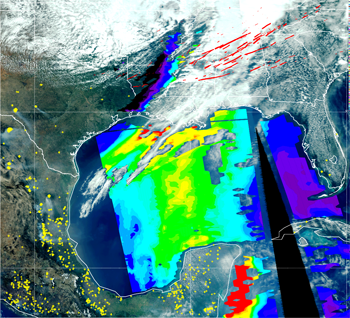
STAR scientists find link between smoke from fires and tornado intensity
This image shows MODIS-Aqua satellite true color image for 27 April 2011 over the southeast US, Central America and the Gulf of Mexico (GoM). Superimposed on the image are 27 April fire detections (yellow), tornado tracks (red) for the period from April 26-28, 2011. Aerosol Optical Depth (AOD) is overlayed with red, green and purple colors showing high (1.0), medium (0.6) and low (0.1) AOD values. Image generated by Brad Pierce NOAA Satellite and Information Service (NESDIS) Center for Satellite Applications and Research (STAR). [Click to enlarge] 5 February 2015 -
A new study, accepted for publication in
Geophysical Research Letters Smoke resulting from spring agricultural land-clearing fires in Central America was transported across the Gulf of Mexico and encountered tornado and severe storm conditions already underway in the United States. The interaction between existing storm conditions and the smoke particles increased the potential for the formation of tornadoes and thunderstorm supercells. "We show
the smoke influence for one tornado outbreak, so in the future we
will analyze smoke effects for other outbreaks on the record to see
if similar impacts are found and under which conditions they occur.
We also plan to work along with model developers and
institutions in charge of forecasting to move forward in the
implementation, testing and incorporation of these effects on
operational weather prediction models."
According to lead authors Gregory Carmichael and Pablo Saide, the smoke lowered the base of the clouds and increased wind shear, defined as wind speed variations with respect to altitude. Together, those two conditions increased the likelihood of more severe tornadoes. The effects of smoke on these conditions had not been previously described, and the study found a novel mechanism to explain these interactions. The team of authors, which included CoRP / ASPB's Brad Pierce and Andy Heidinger, compared computer simulation of the storm event's conditions with and without smoke. Next steps include examining other storm clusters in available data records to see if they manifest similar conditions and outcomes. Thanks to the AGU
Newsroom |
|
